Scotland’s Covid cases tripled in a fortnight and surged to their highest level ever in the wake of schools returning from the summer holidays, official figures revealed today.
The Office for National Statistics’ weekly surveillance report estimated 117,300 people, the equivalent of one in 45 Scots, were infected with the virus on any given day in the week ending September 3. For comparison, the figure stood at 36,700 people, or one in 140, in the seven-day spell to August 20.
It’s the first time the country’s projected weekly case-load has spiralled into six-figures since the pandemic began.
Infection estimates for England showed that the country’s outbreak remained level after it was estimated 754,600 people had the virus last week, or one in 70. But schools in England’s had only been back for a matter of days by September 3.
Scottish pupils returned to classrooms in mid-August and were later blamed for seeding a massive uptick in cases which has only just started to plateau.
Both Northern Ireland and Wales — where schools returned at the same time as in England — saw their infections rise by 10 per cent and 66 per cent in a week, respectively, the ONS report said.
Meanwhile, No10’s top scientists today estimated England’s R rate is at the same level (0.9 to 1.1) as last week in yet another sign that the country’s outbreak was plateauing ahead of the return of schools.
It comes as Professor Chris Whitty and the chief medical officers from the devolved nations prepare to clear the way for vaccinating 12 to 15-year-olds.
England’s chief medical officer, who was asked by No10 to make the final decision on jabbing youngsters, is next week expected to sign off on expanding the roll-out to include all over-12s, it was claimed. It could see secondary school children given jabs from the week commencing September 20.
Advisers told him that the jabs could boost the mental health of youngsters and stop them taking time off school, The Times claims.
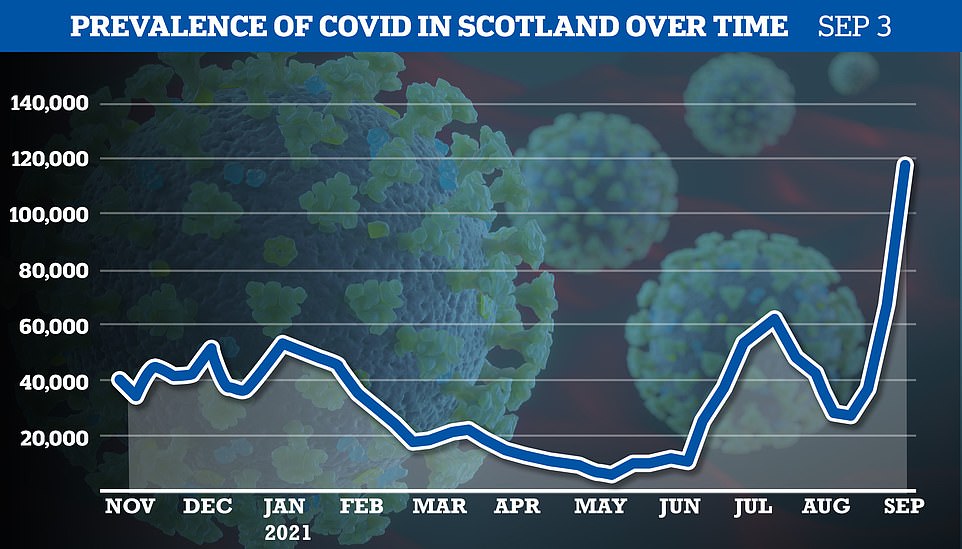
Scotland’s Covid cases have spiralled three-fold in a fortnight, it was estimated today. Office for National Statistics figures showed 117,300 Scots were thought to have the virus in the week to September 3, or one in 45 people. This was up more than 200 per cent from two weeks ago when 36,700 were thought to have the virus
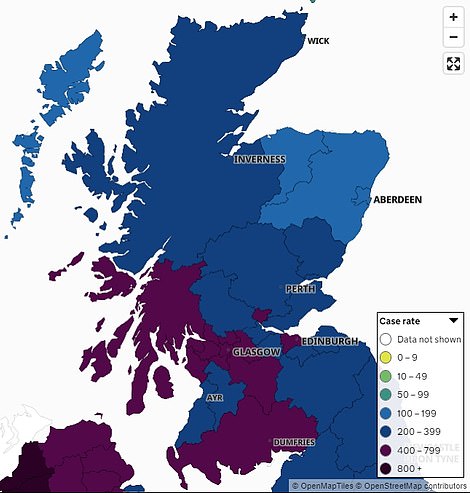
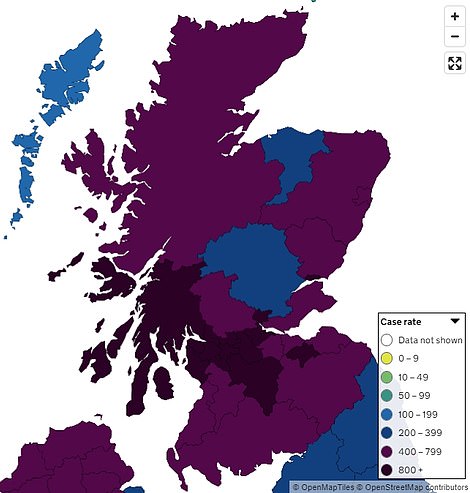
AUGUST 21 (left) AND SEPTEMBER 4 (right): The above maps show the Covid infection rate across Scotland in the week to August 21, a few days after schools in the country returned from the summer holidays, and September 4. They show that cases have surged across the country, particularly around major cities
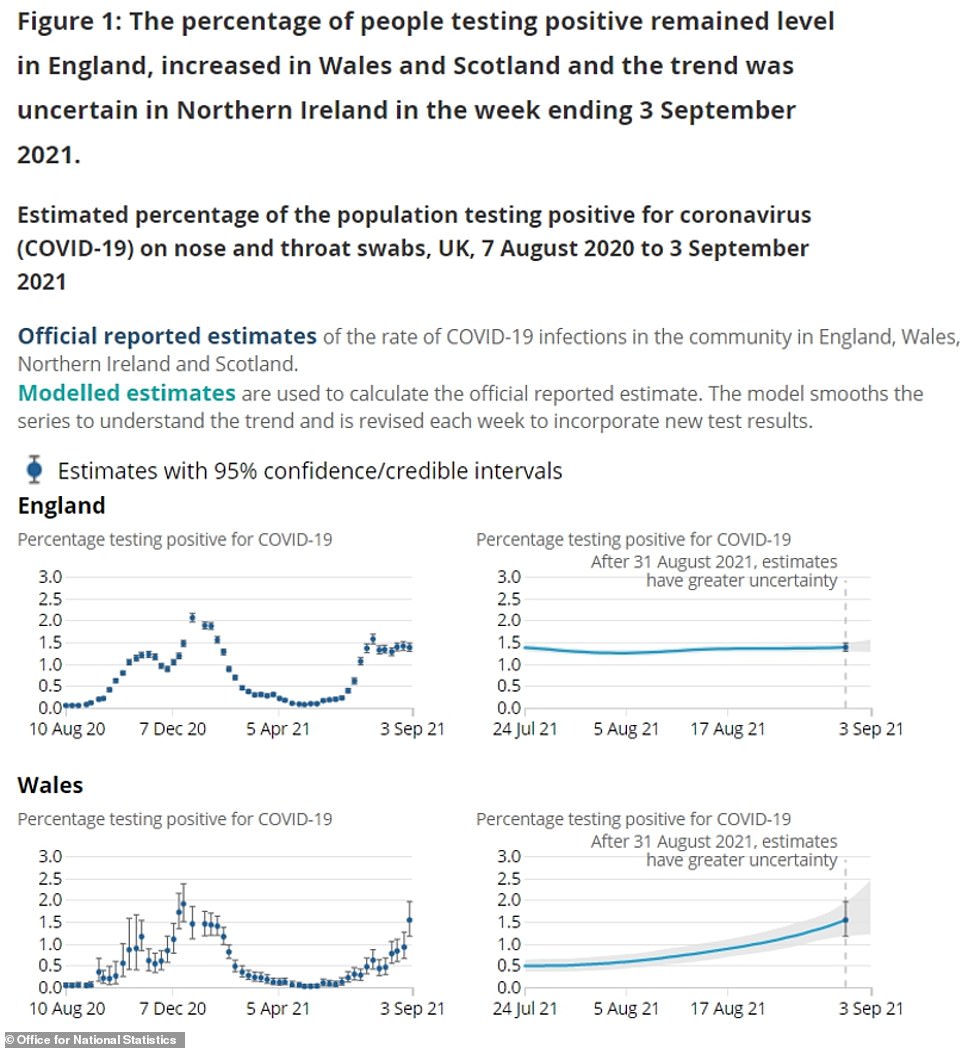
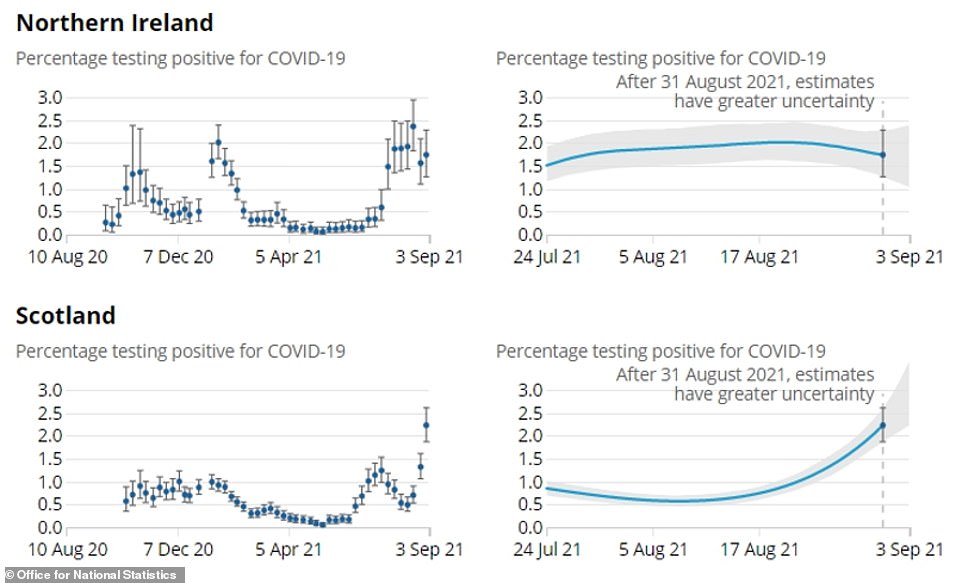
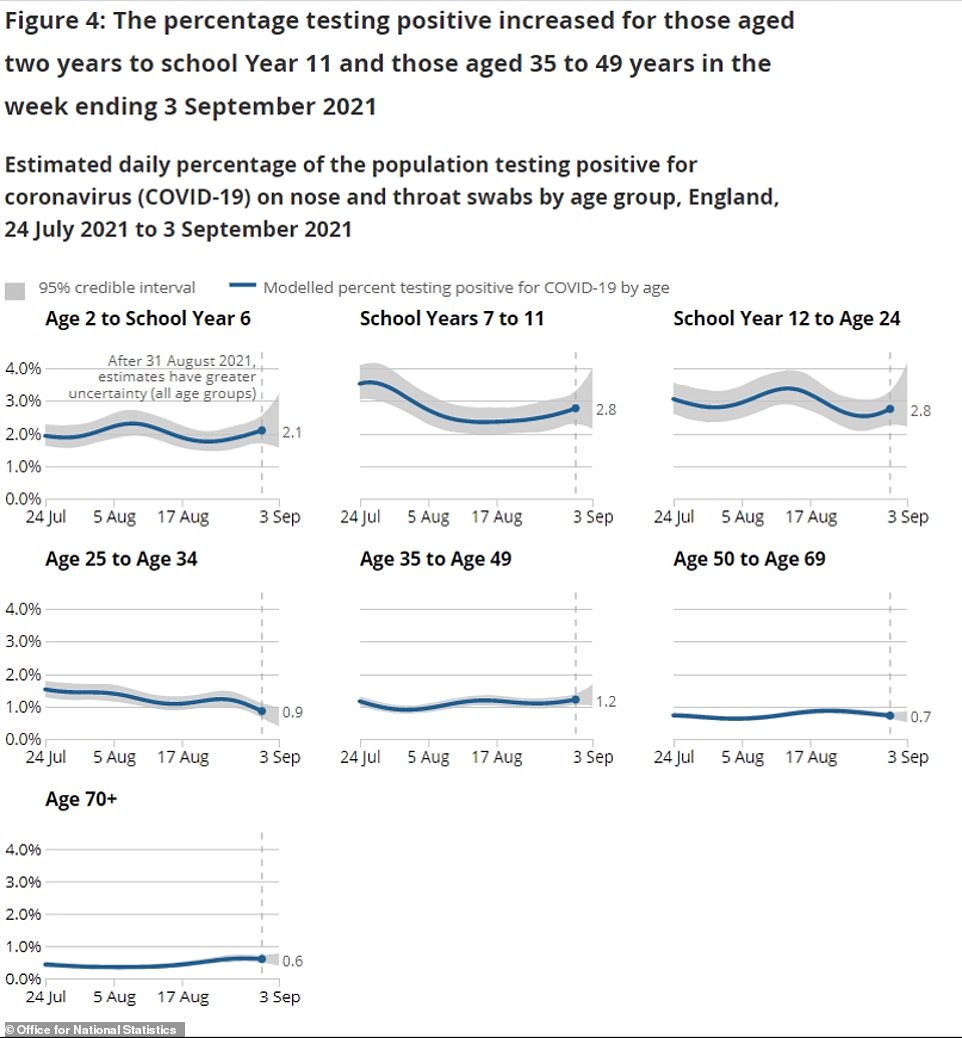
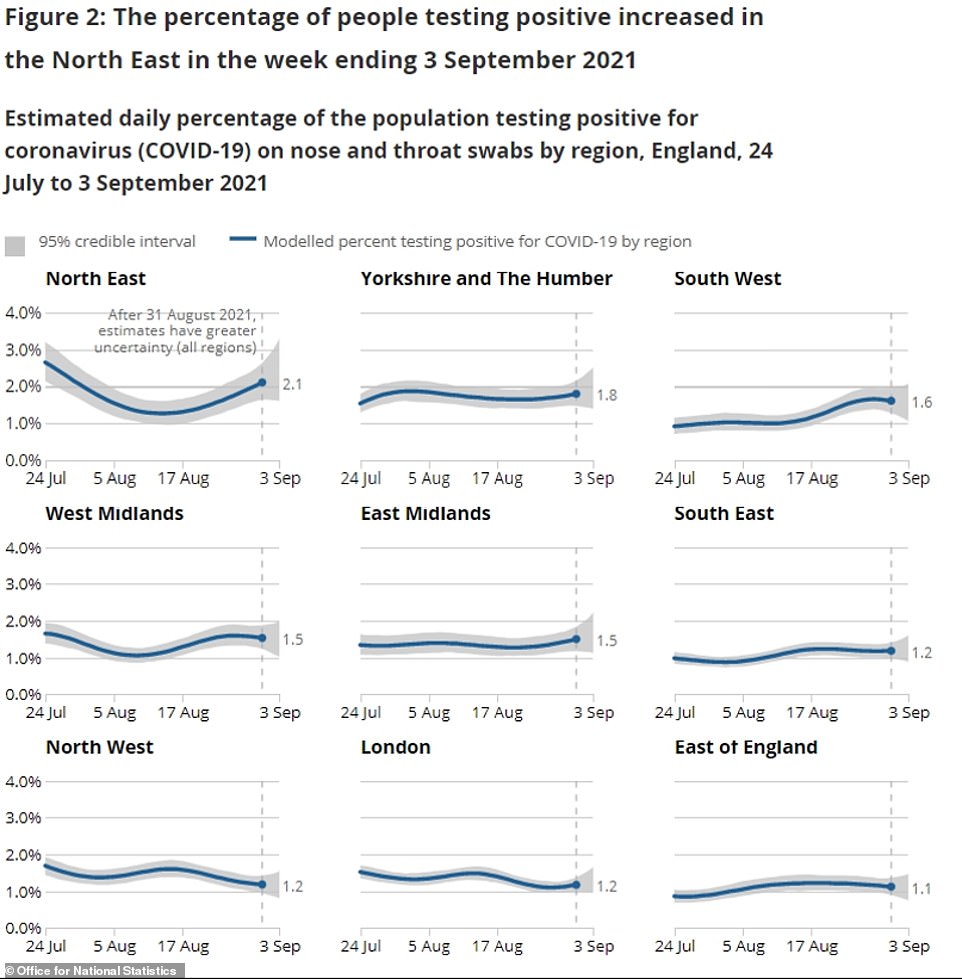
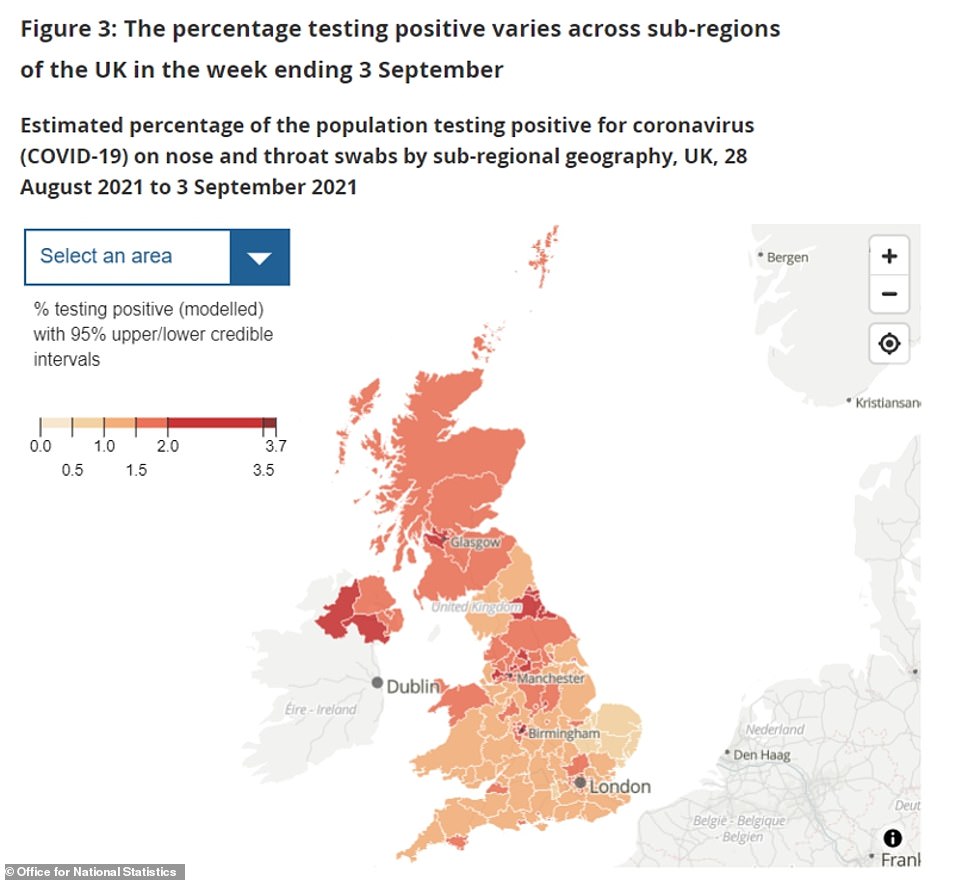
Scottish government advisers yesterday estimated that their R rate — which measures the spread of the virus — was between 1.2 and 1.5, in a warning sign the country’s outbreak is still growing.
It means that for every ten people who catch the virus north of the border, they are passing it on to between 12 and 15 other people.
But the R rate is a lagging indicator, and reflects the situation the country faced itself in several weeks ago due to the data used to calculate it.
Yesterday the Covid symptom study — run by King’s College London and health data company ZOE — said that 5,898 people were catching Covid every day in Scotland, up from 3,503 two weeks ago.
Britain’s booster vaccine drive will get the go ahead next week, reports suggest
Britain’s booster Covid vaccine drive is set to finally get the go ahead next week when No10’s advisory panel signs off on a ‘mix and match’ approach to top-up doses, it was claimed today.
Millions of elderly Britons are expected to receive a top-up jab this autumn after data showed a third dose cause a ‘several-fold increase’ in antibodies, which help fight off the coronavirus.
And Government insiders say the third dose people receive will likely be of a different type to their first two doses because the combination will offer better protection.
But one of the leading figures in the development of the AstraZeneca jab today said a mass coronavirus vaccine booster campaign like that of Israel and the US may not be necessary.
Dame Sarah Gilbert said immunity is ‘lasting well’ for most people and suggested extra doses should be directed to countries with a low rate of vaccination.
She told The Daily Telegraph: ‘We will look at each situation; the immuno-compromised and elderly will receive boosters. But I don’t think we need to boost everybody.’
Health Secretary Sajid Javid yesterday said he expects a booster programme to start later in September but he is still awaiting advice from experts on the scale of any campaign to offer extra shots to people.
Advertisement
In England, it suggested 51,876 people were catching the virus every day in the week ending September 4, down nine per cent on the previous seven-day spell.
This was despite an official Public Health England report that warned infections in the country were rising.
Professor Tim Spector, an epidemiologist and lead scientist of the study, said the return to classrooms ‘hasn’t yet caused a spike’ in infections.
The ONS survey estimated that in Northern Ireland 31,800 people were infected with the virus on any given day last week, compared to 28,700 last week.
And in Wales it said that 46,800 people had Covid, compared to 28,100 in the previous seven-day spell.
Northern Ireland’s outbreak was sparked by younger people mixing more both for social events and in the workplace, official data suggests. Lower vaccination rates among 18 to 39-year-olds are also thought to have been a factor.
In England, the percentage of people testing positive for Covid is estimated to have increased in the North East, with one in 45 people testing positive.
It is thought to have stayed flat in London and the South East and decreased in the North West.
The trend for all other regions is uncertain, according to the ONS.
Infection rates were lowest in the East, where just one in 90 people tested positive.
When modelling the level of Covid infections among different age ranges in England, the ONS said rates have increased for those aged from two to school Year 11.
Around one in 35 people from school Years 7 to 11 and from school Year 12 to age 24 are estimated to have had Covid-19 in the week to September 3 – the highest positivity rate for any age group.
Rates also increased for those aged 35 to 49.
But the percentage testing positive decreased for those aged 25 to 34 and 50 to 69. The trend was uncertain for all other age groups.
Children returned to schools last week in England, Northern Ireland and Wales. But in Scotland they went back in mid-August.
It is expected to take several days before the impact of schools reopening will show up in the daily figures.
Yesterday the UK’s daily Covid cases remained flat on the week before. Department of Health chiefs posted 38,013 new infection, down 0.4 per cent on the 38,154 recorded last week.
Deaths also fell yesterday, with 167 fatalities recorded — a drop-off of 6.2 per cent on the 178 seen last week.
But the number of hospital admissions remained flat. Some 863 Covid patients were admitted on Sunday — the most recent date data is available for, up 1.8 per cent on the week before.

 ‹ Slide me ›
‹ Slide me ›
Rates are rising in all regions of England except south-west England. Map shows: The percentage change in infections in regions across England in the week ending September 5 (right) and the week before (left)
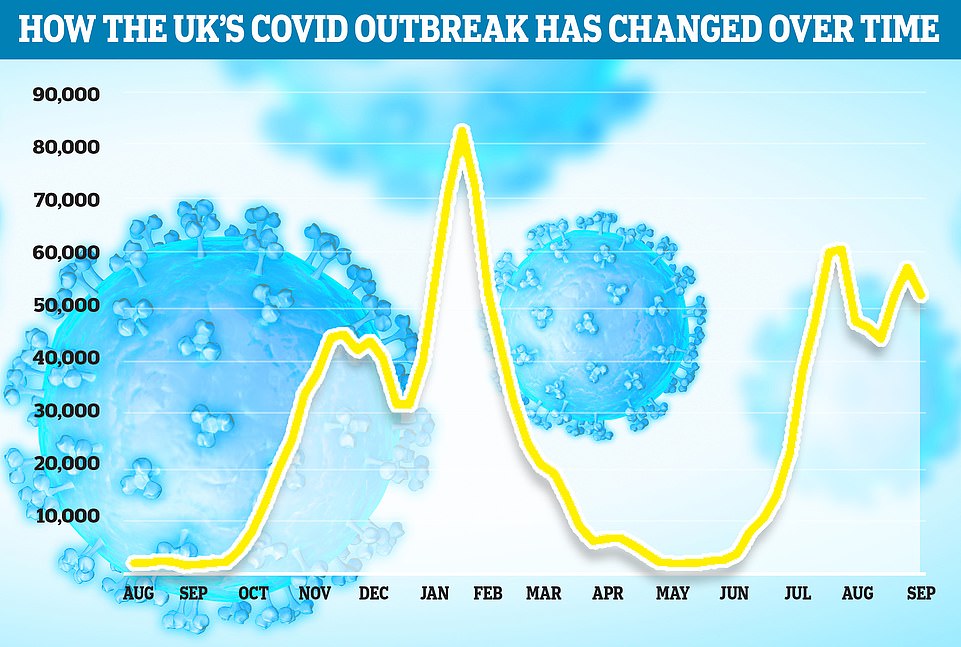
Data from King’s College London scientists has suggested 51,876 people suffered with the virus in the week ending September 4, down nine per cent on the previous week (57,158)
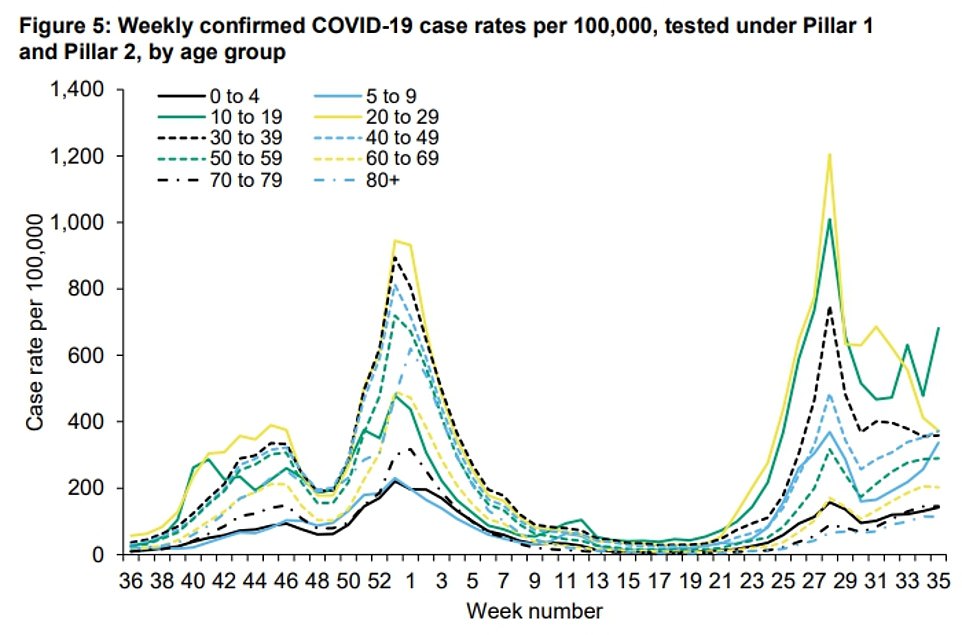
Figures from Public Health England show cases in children aged 10 to 19 spiked by 42 per cent in a week from 478.3 per 100,000 to 681.4 in the week ending September 5. This was nearly six times higher than the 114 cases per 100,000 in over-80s — down 1.2 per cent from the week before — and 145.8 in 70- to 79-year-olds — which remained flat

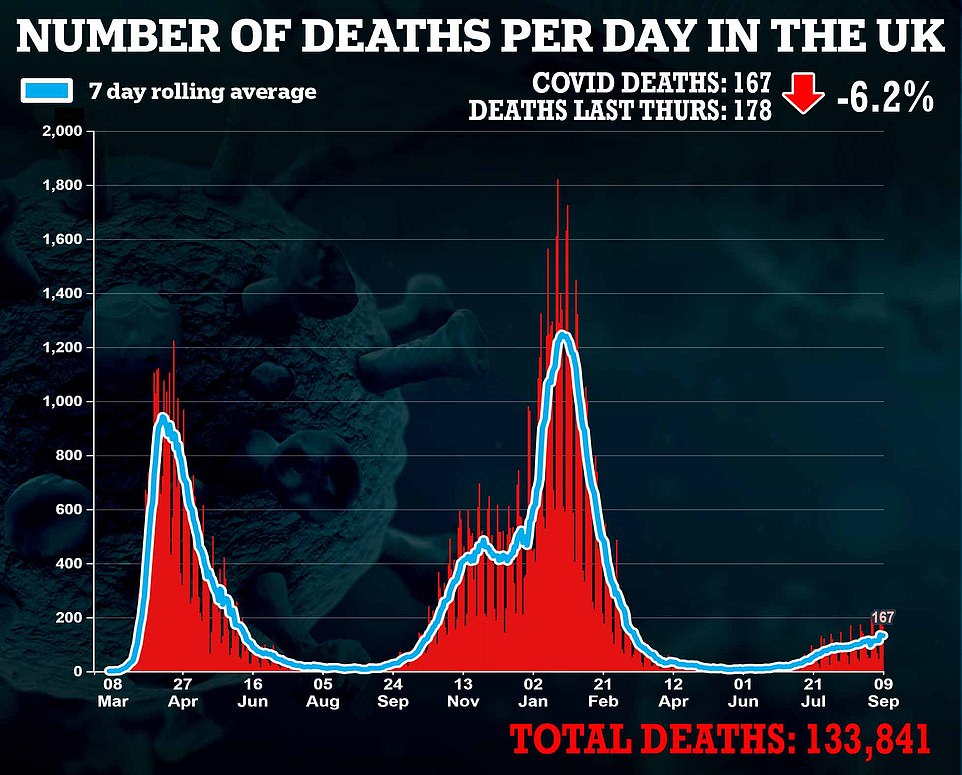

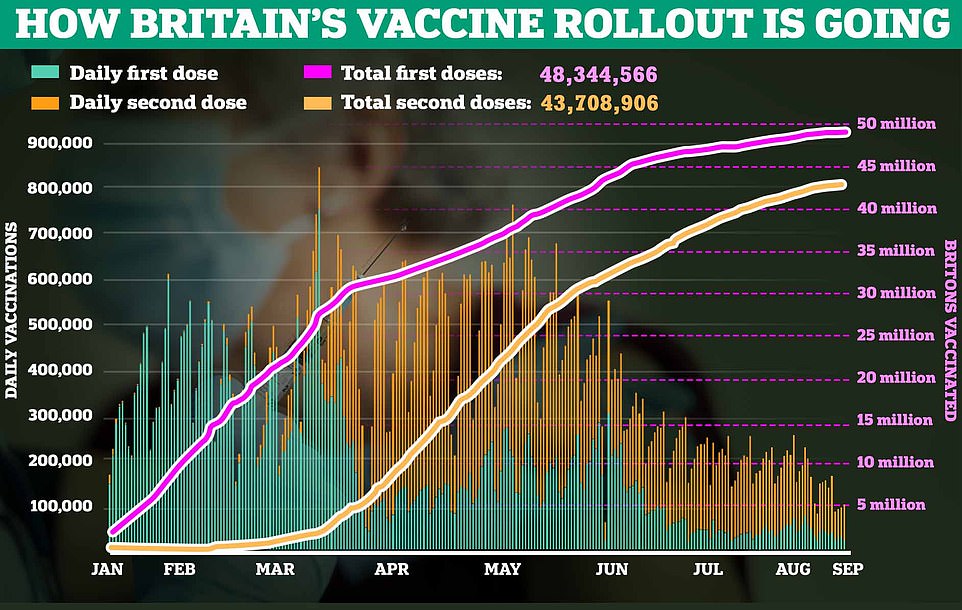
Teenage boys are SIX TIMES more likely to get rare side effect than be hospitalised with Covid
Teenage boys are six times more likely to get a rare side effect from the Covid vaccine than be hospitalised with the disease, according to a study.
California University researchers found that boys aged 12 to 15 who got two doses of the vaccine had a rate of inflammation of the heart, or myocarditis, of 162.2 cases per million people.
For comparison, their rate of hospitalisation with the disease was 26.7 per million.
But the researchers also found that the rate of hospitalisation among those who got just one dose was 13 per million, below the admissions rate.
Professor Chris Whitty and the chief medical officers from the devolved nations are currently weighing up whether to inoculate 12 to 15-year-olds in Britain.
They are expected to give the plans the green light early next week, but some SAGE experts say it is likely children will only be offered one dose.
When the drive was expanded to 16 and 17-year-olds, they were only offered one dose of the vaccine.
An unnamed SAGE scientist told the i newspaper: ‘With both Moderna and Pfizer vaccines offering high levels of protection after just one dose this is one course of action being considered.’
The study looked at reports of adverse cardiac events in the US among 12 to 17-year-olds between January and mid-June this year.
Children in the country have been able to get two doses of the jab since May, with 177million having already received both jabs.
Adverse cardiac events were defined as cases of myocarditis, pericarditis and chest pain, the technical names for inflammation of the heart.
They found 257 adverse cardiac events after vaccination of which the vast majority (220) were recorded after a second dose was administered.
There were only 25 adverse cardiac events among girls, and none were recorded after the first dose.
This gave them a rate of 13.0 myocarditis cases per million after the second dose.
The study was published as a pre-print on site medRxiv, meaning it is yet to be peer-reviewed by other scientists.
Advertisement
PHE data yesterday showed the overall the number of positive cases last week rose from 171,798 to 187,059.
Case rates in England are continuing to rise in most age groups, PHE said. The exceptions are 20 to 29-year-olds, 60 to 69-year-olds and people aged 80 and over.
The highest rate is among 10 to 19-year-olds, with 681.4 cases per 100,000 people in the seven days to September 5, up sharply week-on-week from 478.3. The second highest rate is among 20 to 29-year-olds, down from 412.1 to 373.2.
But the lowest rate is among people aged 80 and over, at 114.0, down slightly from 115.4.
Rates are rising in all regions of England except south-west England, according to PHE. North-east England has the highest rate, with 378.6 cases per 100,000 people in the seven days to September 5, up from 320.3. Yorkshire and the Humber has the second highest rate at 378.4, up from 343.0.
London has the lowest rate at 240.0, up slightly from 237.5.
Dr Yvonne Doyle, Medical Director at Public Health England, said: ‘Case rates remain high although fairly stable across the country and are currently highest in those aged 10-19 years old.
‘We expect to see more cases in this age groups as schools detect cases of COVID-19 acquired during the summer holidays. We continue to closely monitor how the start of the school year is impacting infections and will review recommendations accordingly.
‘In recent days many have begun to return to the workplace.
‘It’s important to keep following the simple steps to help protect yourself and others, get both doses of the vaccine, wear a face covering in enclosed spaces and if you have Covid symptoms, please do not go out.
‘You should only leave home to get a PCR test, which you should get as soon as possible if you have symptoms.’
It comes after the Government’s own vaccine advisory panel, the Joint Committee on Vaccination and Immunisation (JCVI), last week ruled that the benefits of vaccines were only ‘marginally greater’ than the known risks for 12 to 15-year-olds.
Both Pfizer and Moderna’s jabs have been linked to a rare heart complication called myocarditis in young adults and children.
Following the JCVI ruling, ministers asked Professor Whitty and the UK’s other chief medical officers in Scotland, Wales and Northern Ireland to carry out a wider review to weigh up the societal benefits of inoculating children, to see whether this would tip the balance clearly in favour of jabbing the group.
The full details of this review are yet to be published although they are set to be formally announced next week when the chief medical officers present their decision on vaccinating children.
SAGE members have suggested giving the youngest children just one dose of the jab because it offers ‘high levels of protection’ and carries less risk of myocarditis, inflammation of the heart heavily linked to the second vaccine.
One expert on the panel told the i newspaper: ‘With both the Moderna and Pfizer vaccines offering high levels of protection after just one dose this is one course of action being considered.’
Concerns over vaccinating children have centered around the complication, which appears to be mild but can strike up to one in 15,000 teenage boys after their second dose.
A University of California study yesterday revealed boys are six times more likely to suffer the side effect after two doses of the vaccine than be hospitalised if they catch the virus.
But they found their risk of experiencing the rare side effect after one dose was so low that it made hospitalisation with the disease more than twice as likely.
British teenagers aged 16 and 17 have been able to get one dose of the Covid vaccine since last month, when the JCVI approved the expansion of the roll-out. Scientists are still yet to decide whether they should also be offered a second dose of the jab because of the myocarditis risk.
Parents will also be asked for consent to inoculate their children once the jabs receive the green light, with forms set to be posted within days of the announcement.
Source link : https://www.dailymail.co.uk/news/article-9977461/Scotlands-Covid-cases-TRIPLED-fortnight-return-schoolchildren-official-data-reveals.html











